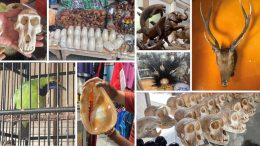Many people see the Indonesian island of Bali as a tropical paradise, with something for everyone. Tourists flock there by the millions — about 16 million in 2024 alone. Some visit for the island’s amazing beaches, plenty of sunshine, excellent surfing, good food and drinks. Others come for the arts, meditation, ancient Balinese cultures, or the amazing landscapes, mountains, nature and endemic wildlife.
We understand the draw of Bali: It’s a beautiful island treasured both by those who live there and visit.
But few people realize that Bali is also a center for Indonesia’s domestic and international wildlife trade.
And it’s not hidden.
Previous researchers and conservation NGOs have raised alarms about Bali’s substantial role in the trade of marine species. In the 1990s fishermen landed some 20,000 green turtles in Bali annually and these were traded domestically. In the 2000s exporters took a central role in the export of Banggai cardinal fish, with tens of thousands of fish exported each month. And the seas north of Bali remain heavily exploited for corals for the international aquarium trade.
Some of this trade was well-known within Bali and led to awareness campaigns by local and international NGOs and, while it was never hidden, it was easy for outsiders to ignore or not notice.
Over recent years, we’ve undertaken a comprehensive assessment and quantification of Bali’s wildlife trade. This initiative marks a critical first step in identifying and curbing illegal wildlife transactions that contravene local and national laws, while simultaneously enhancing the regulation and oversight of legal trade practices. Unlike previous work, we did not focus on one particular type of wildlife for sale. Instead we aimed to collect data on as wide a range of species as possible. We focused on two sets of species: animals whose trade is restricted or banned under the Convention on International Trade in Endangered Species, and others that are legally protected by Indonesia or for which their commercial trade is regulated.
As we progress through our assessment, we’ve uncovered a startling prevalence of wildlife trade in Bali — much of it previously unreported or underreported.
Trade in CITES-Listed Species
We found a widespread availability of CITES-listed species for sale in wildlife trade shops, art markets, and “antique” shops.
Building upon our initial observations, we conducted a comprehensive survey of Bali’s wildlife trade, revealing a concerning prevalence of endangered species products openly available in the market. We observed almost 1,000 primate skulls for sale, some 600 chambered nautilus shells, and 500 black coral bracelets, as well as 75 sperm whale teeth, 50 babirusa skulls, and 20 sun bear teeth.
Disturbingly, the majority of these items were displayed in shops catering predominantly to foreign tourists. When we approached vendors, they assured two of us — Jessica, a U.S. citizen, and Vincent, a Dutch citizen — that transporting these items home would pose no issues. However, none informed us of the necessity for CITES permits, highlighting a concerning lack of awareness or transparency regarding international wildlife trade regulations.
In fact, based on previous CITES records, the majority, if not all, of these items will be exported without any CITES permits. All primates are listed on CITES, meaning all international trade in them is regulated and requires permits from the Indonesian CITES Management Authority. Over the past 25 years, Indonesia only ever gave permits for primate skulls twice: a macaque for export to the U.S. in 2005 and a Bornean gibbon for export to Thailand in 2016.
Beyond the species we could readily identify and quantify, we also encountered numerous items crafted from CITES-listed species, where assessment proved more challenging.
For example, at least 10 species of Dalbergia rosewoods are native to Indonesia, with Indian and North Indian rosewoods being commercially exploited for timber. Since 2017, all Dalbergia species have been listed in CITES Appendix II, requiring export permits for international trade. In Bali’s most tourist-centric areas, over 100 shops sell wood carvings, many specifically targeting tourists. During our visits, knowledgeable vendors consistently presented carvings made from rosewood. None, however, mentioned the necessity of CITES permits. This oversight suggests that tourists purchasing these items may unknowingly engage in the illegal cross-border trade of CITES-listed species.
Trade in Legally Protected Species
Some of the species that we mentioned above are not only listed on CITES but are also legally protected in Indonesia. This includes some, but not all, primate species, one type of chambered nautilus, sperm whales, babirusas and sun bears.
Other protected species we observed openly offered for sale were Javan porcupine (skulls are traded as novelty aquarium objects), Javan deer (antlers are carved in myriad ways), and horned helmet (shells are sold as decorative objects or portable souvenirs), along with dozens more. Much of this trade was targeted at foreign tourists, who again were unaware that their purchases involved the illegal cross-border trade of protected wildlife.
There is also a substantial live trade in legally protected animals, mainly birds and freshwater fish. Different from the trade that targets foreign tourists, this is clearly a domestic trade. Live birds and fish are not offered in the main tourist areas but in specialized animal markets in the main cities. We observed hundreds of legally protected birds sourced from various parts of Indonesia (Sumatra, Java, Indonesian Borneo, Sulawesi, Papua) for sale at the three main animal markets in Bali (Satria, Sanglah and Beringkit).
A Note on “Antiques”
While an antique is traditionally defined as a collectible item at least 100 years old, many Balinese antique shops offer a diverse array of products, the majority of which are of more recent origin. Some items are newly crafted to mimic the appearance of age through techniques such as staining and distressing, blurring the lines between authentic antiques and contemporary reproductions.
Solutions to This Global Problem
Our focus on Bali’s wildlife trade stems from the understanding that addressing these pressing challenges extends beyond the purview of Indonesian conservation authorities alone.
Tourism is the cornerstone of Bali’s economy, much of the island’s income is derived from this sector. For many visitors, Bali’s reputation for environmental stewardship and natural beauty is a significant draw, often leading to repeat visits.
This strong connection between tourism and environmental appeal presents a unique opportunity to leverage public interest in conservation to combat the illegal wildlife trade effectively.
While the total amount of wildlife we observed offered for sale was much larger than we anticipated, the trade seems to be concentrated in a few areas in southern Bali. Out of the thousands of shops selling to tourists, we repeatedly observed CITES listed or protected wildlife for sale in just over 100 stores. Based on what is on offer at any given time, the sale of protected and/or CITES listed wildlife represents only a small proportion of most shops’ overall revenue. Ending the sale of this wildlife is unlikely to cause financial hardship for the majority of shop owners.
We feel the best way to achieve this would be a short but effective campaign to actively enforce existing legislation through the confiscation of illegal items; prosecution of sellers; and public education. This would need to include publicizing any successful prosecutions — a big change from current practice, where law enforcement agencies hold press events to announce seizures and arrests but don’t promote what happens next.
This would best be achieved through a collaboration between the Balinese tourism community (hotels, tourism boards, travel agents), businesses (through the local chapter of the Chamber of Commerce), expats living in Bali, and the governor of Bali’s office.
To effectively combat wildlife trafficking in Bali, it is imperative to strengthen inter-agency collaboration both within the island and across Indonesia. This necessitates coordinated efforts among conservation organizations, local governments, and law enforcement agencies — including forestry officials, police, customs, and prosecutors. Such collaboration should focus on sharing intelligence regarding trafficking networks and allocating resources to enhance enforcement capabilities, thereby improving the overall effectiveness of anti-trafficking initiatives. It is also paramount that the Indonesian CITES Management Authorities (based in Indonesia’s capital Jakarta on Java) liaises better with its international counterparts to address this international trade. This includes Australia, the EU, China and the United States, countries with which Indonesia already has strong trade links.
And an equally important step starts with the thousands of tourists who visit Bali each year: Don’t buy wildlife products, and don’t support the retailers who sell them. You’re coming to the island to enjoy its natural beauty: Leave wildlife in the wild where it belongs.
Part of this work was supported by the United States Department for Agriculture’s Agriculture Research Service (USDA ARS NACA number 20230048, grant number 58-3022-2-020). These findings do not represent official views or endorsements of the United States Government.
Further reading:
Chavez J, Nijman V, Payuse INAD 2023. Trade in sperm whale curios in Bali. Oryx 57(6): 695-696.
Chavez J, Payuse INAD, Kuntayuni, et al. 2024. Tourism, international wildlife trade and the (in)effectiveness of CITES. Environmental Conservation 51(1): 64-70
Chavez J, Kuntayuni, Nijman V 2024. Trade of skulls as novelty and aquarium objects are an additional threat to porcupines. Journal of Threatened Taxa 16(1): 24584-24588.
Chavez J, Nijman V 2024. The open sale of primate skulls on Bali reveal complex Indonesia-wide wildlife trade networks. Primate Conservation 38: 175-184.
Chavez J, Campera M, Hensley LE, et al. 2025. Illegal wildlife trade in a tourism and biodiversity hotspot. Sustainable Development
Previously in The Revelator:
Cash for Corals: Exploiting Ecosystems on Their Way to Extinction



